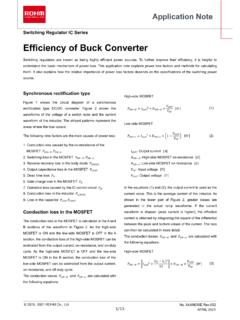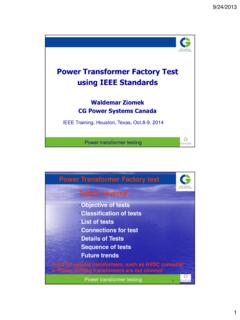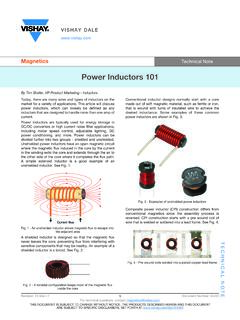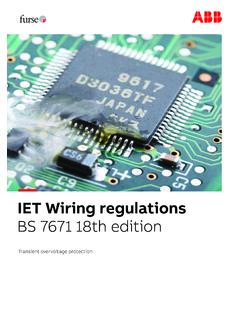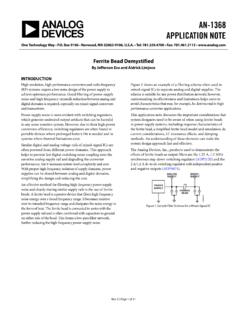Transcription of A Tutorial Introduction to Switching Converters
1 A Tutorial Introduction to Switching Converters Christophe Basso Business Development Manager IEEE Senior Member February 2022 Rev Agenda Power Conversion Mechanisms Switching Cells and Control Schemes The Buck The Boost The Buck-Boost Introduction to Control Loop Design EMI Filter Interaction Introduction to Simulation The Goal of a Converter is to Deliver Power A converter transforms the energy from a source into a physical work The conversion mechanism generates losses and heat which must be evacuated Only way to feel the noise Pin Noise source Pout It's when it's good and loud . Electrical Dc-dc source Power amplifier Transducer Work conversion Energy efficiency is about minimizing the losses in the conversion chain A highly-efficient converter implies lower-size heatsink and improved reliability No Loss in a Perfect World In an ideal system, all the energy coming from the source converts into work By the ratio between the delivered power and the input power is efficiency The Greek letter eta designates a unitless number less than 1 or 100%.
2 Pout . Pin Pout 1 . Ploss Pin Pout Pout Pout 1 .. A 50% efficiency means Ploss = Pout Pout = 100 W Ploss = 100 W. Pin = 150 W, Pout = 100 W = 66%. Efficiency is not constant and often peaks at a level different than nominal power Challenge is to keep losses low across a wide load range Efficiency Across the Load Range Computers are rarely used at their full power capability Depending on the active program, computational burden affects consumption The 80+ standard established in 2004 defines efficiency at different load conditions 115 V Internal Non- 80 PLUS Test Type 230 V Internal Redundant Redundant Power supply usage 20 % 50 % 100 % 10 % 20 % 50 % 100 %. 80 PLUS 80 % 80 % 80 % Not defined 80 PLUS Bronze 82 % 85 % 82 % --- 81 % 85 % 81 %. 80 PLUS Silver 85 % 88 % 85 % --- 85 % 89 % 85 %.
3 80 PLUS Gold 87 % 90 % 87 % --- 88 % 92 % 88 %. 80 PLUS Platinum 90 % 92 % 89 % --- 90 % 94 % 91 %. 80 PLUS Titanium Inexistant 90 % 94 % 96 % 91 %. Performing Power Conversion Power conversion can be done in two ways, linear or switched The linear approach relies on a controlled resistance to regulate the flow The Switching approach uses a power switch either open or closed control The linear approach: Vin Vout o efficiency is poor o good noise performance o acceptable when (Vout-Vin) is small MC7805. Linear regulator R from 0 to o can only decrease the input level control The Switching approach: o efficiency is high control Vin o noise performance is poor Vout o works with large (Vout-Vin). R is 0 MC34063. or o increase/decrease/invert the input level Switching regulator R is.
4 O requires energy-storing elements Associating Resistors to Lower the Voltage Associating resistors together is a way to reduce the voltage It is however difficult to keep a stable value when operating conditions change R2. V 52 132 Rload2 3V3 Pout 468 mW. 50. DSP 100 50. DSP. R1 122 122. 140 Pin W. 100 140 50 132. Vin 5V. 5V. Rload1. 12V 100 logic logic Pout 100 Pin Efficiency is poor and power dissipation can be high Not suited for highly-variable output currents A Controlled Resistance The series resistance can be replaced by a controlled element such as a transistor An error amplifier monitors the output voltage and adjusts the driving bias Vout I FB. >. I in Feedback I out If the feedback current is R1. I bias network neglected: >. Conversion Ib ratio C1 R3 Pout Vout I out Vout Vin M.
5 Pin Vin I in Vin U2. Vref R2. The efficiency depends on the difference between input and output voltages Linear Regulators can be Efficient A small difference V between Vin and Vout brings good efficiency Efficiency betters if the V drop is reduced compared to Vout 6V 5 V/1 A. Vout 5. 83%. Vin 6. V << Vout 13 V 12 V/1 A. Vout 12. Vin 13. Vout = 5 V. Modeling a Linear Regulator Any linear system can be reduced to its equivalent Th venin generator A voltage source Vth is affected by an output resistance Rth Q1. Z out ,OL. R4 Small-signal model R3. Vin C1 Vth Vin , Vbe , VZ Vout D1. Th venin generator The output voltage is made of three contributors: Vin, Iout , Vbe and VZ. Description by Block Diagrams It is possible to represent the linear regulator with blocks The H stage describes the bipolar transistor power stage transfer function I out s Z out ,OL s.
6 As ,OL s Vin s . - +. Vref s H s Vout s . Power stage We can easily write the equation describing the output voltage expression Vout s Vref s H s I out s Z out ,OL s As ,OL s Vin s . Power stage Open-loop output Open-loop impedance input voltage contribution contribution Benefits of closing the Loop The deviation between the reference and the output generates an error . The error is then amplified and shaped by the compensator Error amplifier I out s Z out ,OL s . As ,OL s Vin s . - + +. Vref s Error G s Control H s Vout s . voltage voltage - Power stage Vout s Vref s Vout s T s I out s Z out ,OL s As ,OL s Vin s . Loop gain T s Z out ,OL s As ,OL s . Vout s Vref s I out s Vin s . 1 T s 1 T s 1 T s . T s G s H s . Theoretical output Closed-loop Closed-loop output impedance input rejection ratio Sensitivity Function A converter robustness qualifies its ability to reject perturbations The input voltage, the output current or temperatures are perturbations A high loop gain guarantees efficient perturbation rejection and improves robustness T s.
7 Vout s Vref s I out s Z out ,CL s Vin s As ,CL s . 1 T s . Static error 0. T s T0 . Vout s Vref s Vout s Vref s No static error 1 T s . Output impedance T0 . 1. Z out ,CL s Z out ,OL R0,CL 0 No output drop 1 T s . PSRR T0 . 1. Asc ,CL s Asc ,OL Asc ,CL 0 Infinite input rejection 1 T s . Sensitivity function Small-Signal Parameters The output impedance and the rejection ratio are all small-signal parameters The static values can be measured in a two-step approach Dc Vin1 Vout1 I PSRR. out Vout As ,OL . Vin 2 Vout 2 I out Vin Vout1 I R0. out 1 Vout Vin R0,CL . Vout 2 I out 2. I out Keep the input voltage or output current variations small for a linear behavior dVout A small variation means a differentiation: R0,CL Vout 2 Vout1 R0,CL . I out 2 I out1 dI out Small-signal representation only I out 2 I out1 0 I out No Gain, no Feedback!
8 We know the loop gain must drop to force crossover at a given frequency Crossover determines the dynamic behavior of the converter: speed, reaction time As long as the perturbation frequency is before crossover, correction occurs When perturbation frequency is beyond crossover, ac feedback is gone: open loop! dB Loop gain transfer function 80 180 T f . Vin Vout(s). 40 90. H1(s) H2(s). T f . 0 0. T(s) f0. d(s). -40 -90. fc dc Loose coupling Open f < fc in ac, no signal Ac closed-loop transmission >> fc -80 -180 loop G(s). ac 10 100 1k 10k 100k f0 >> fc Agenda Power Conversion Mechanisms Switching Cells and Control Schemes The Buck The Boost The Buck-Boost Introduction to Control Loop Design EMI Filter Interaction Introduction to Simulation Core Switching Cells The basic Switching cells consist of three different Converters The buck converter it reduces the input voltage The boost converter it increases the input voltage The buck-boost converter it can increase or decrease the input voltage Vout Vout Vout control Vin control Vin Vin control Vout Vin Vout Vin Vout or Vin Buck Boost Buck-boost A Two-Switch Model Each basic structure shares a common switch + diode arrangement The Switching cell is actually a single-pole double-throw power switch Switching cell
9 Switching cell a L Vout L c p Vout SW c + +. D. D C R SW C R. Vin Vin p - - a Buck converter Boost converter Switching cell a p Vout PWM switch c - model a c a: active SW D. L C R c: common Vin p: passive + d PWM switch VM p Buck-boost converter Frequency and Duty Ratio The duty ratio D defines the on-time duration divided by the Switching period Tsw vDRV t . On-time ton toff Tsw on-time off-time t D on ton DTsw Tsw ton toff Tsw DTsw D ' Tsw toff D' toff D ' Tsw D ' 1 D. t Tsw Off-time Tsw There are two events in the switch activation: one switch is off while the other is off This is typical of a converter operated in continuous conduction mode or CCM. A third event with all switches off occur in discontinuous conduction mode or DCM. For all basic cells, the duty ratio D controls the output voltage Inductive Current The current in an inductor ramps up and down during the Switching period V A.
10 The current slope S in A/s depends on the voltage applied across the inductor: S . L s . The inductor energizes (stores energy) during the on-time The inductor de-energizes (releases energy) during the off-time iL t . d . Operating The distance between Ipeak and Ivalley I peak transient S 'off defines the ripple current IL. iL t Current starts from Ivalley and returns to I valley Son Soff the same level within the Switching cycle clock I L clock If current keeps increasing: saturation t If valley current is the same within one cycle: steady-state operation Conduction Mode The peak and valley currents determine the amount of processed energy Their levels depend on operating conditions set by input and output values iL t . I peak I out1 CCM: continuous CCM.


